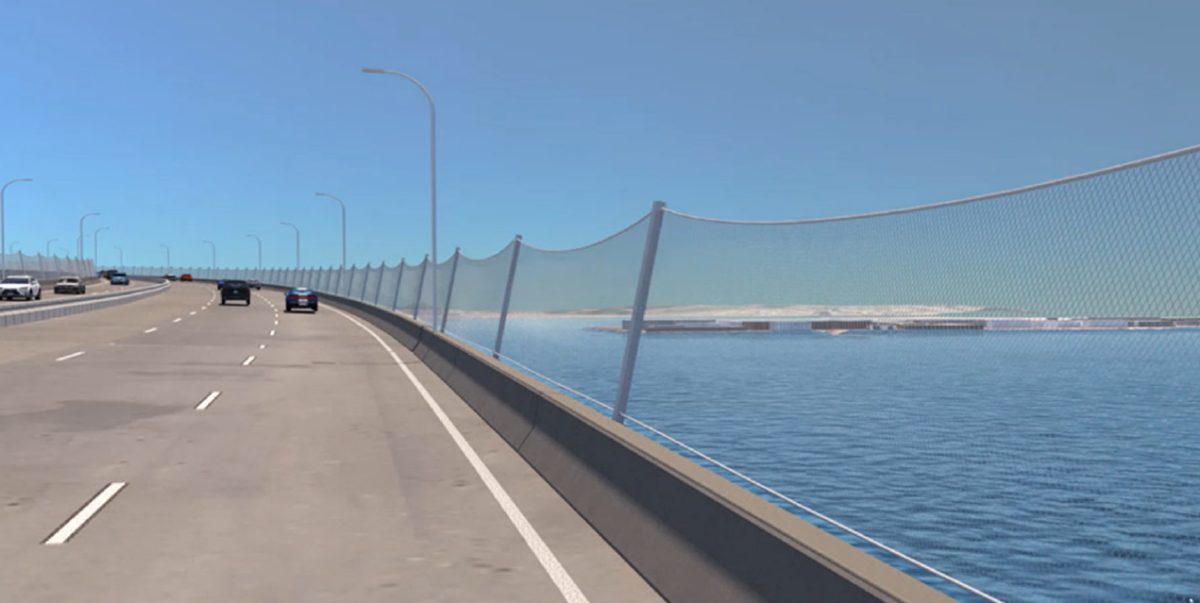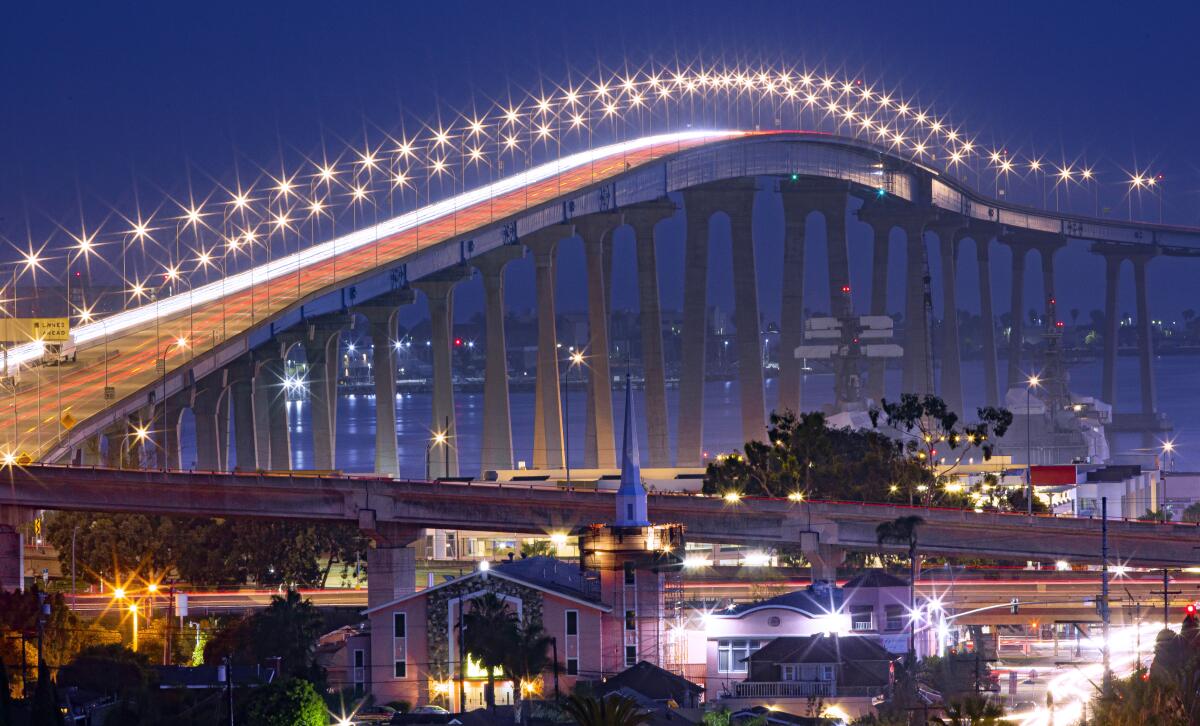Caltrans settles on vertical steel suicide barrier for San Diego-Coronado Bridge

- Share via
SAN DIEGO — Caltrans has moved closer to installing a suicide barrier on the San Diego-Coronado Bridge with a new report that identifies a vertical stainless steel net as the best option.
The net would be 8 to 10 feet tall, according to the report, and attached by cables to poles bracketed onto the bridge’s 34-inch-tall concrete sidewalls.
More than 400 people have died jumping 200-plus feet into the water off the bridge since it opened in 1969, making it second only to San Francisco’s Golden Gate Bridge for the most suicides statewide. The concentration of deaths there is the highest at any state highway location in San Diego and Imperial counties.
Amid growing community and political pressure, the California Department of Transportation installed 4-inch-tall metal bird spikes on the walls as an interim measure three years ago while it studied more permanent solutions. The spikes, meant more as a psychological deterrent than a physical one, have not slowed the suicides, which occur on average more than once a month.
Authorities also have often closed the bridge, sometimes for hours, as they approach would-be jumpers. There are more than 83,000 average daily trips across the five-lane span.
In the new report, Caltrans says it evaluated about a dozen alternatives for a barrier — various types of wire-mesh fences, glass panels, a horizontal net strung below the bridge deck, tall thistles — before settling on the vertical steel net as the best option.
“I think it’s wonderful that we’ve reached this point,” said Wayne Strickland, a retired Coronado firefighter and leader of a community group that has pushed for a barrier for almost a decade. “Now we just have to keep pushing until it’s actually done.”
The net would be installed on both sides of the bridge for its entire 2.1 miles, from above the Bayshore Bikeway on the Coronado side to Newton Avenue on the San Diego side.
A continuous steel plate would be put on top of the existing walls to provide brackets for poles spaced approximately 20 feet apart. The net would be attached to the poles with tension cables at the top and bottom. The barrier would be offset behind the existing walls by 4 to 8 inches and would angle outward slightly.
The net would be a minimum of 85% transparent, according to the report — an important feature because that would minimize one of the project’s major environmental impacts: the loss of scenic vistas, both on and off the bridge, which are part of the structure’s historic character.

After looking at almost two dozen potential environmental impacts in the new report, Caltrans believes the barrier can be designed and constructed to mitigate them. That would eliminate the need for a full environmental review, potentially shortening the timeline for the project.
As it is, the agency is looking at a likely minimum of five years before construction could begin. The public will have a chance to review and comment on the project — a virtual meeting is scheduled for Feb. 10 — and various local and state regulatory agencies would have to approve permits for it.
Funding will be a significant hurdle. Stefan Galvez, principal transportation planner for Caltrans, said the estimated cost of the project is $140 million. That includes the barrier and new enclosed workspaces under the bridge to allow for painting, repairs and other maintenance jobs that are currently done from on top of the span.
Suicide barriers don’t qualify for highway safety funding in Caltrans’ budget, so other sources would have to be found. Two local city council members, Bill Sandke in Coronado and Raul Campillo in San Diego, recently called on a regional planning agency to reallocate $25 million earmarked in 2004 for a tunnel from the bridge to North Island Naval Air Station. It was never built and is no longer under consideration.
“Over 400 people have died by suicide on our region’s iconic bridge, and we as leaders have a duty to stop this,” Campillo said in a statement.
If the project is approved and funded, Caltrans would move into final design and construction, Galvez said. Each phase would take about three years, he said, although there could be some time-saving overlap. One key design issue will be minimizing the ability of someone to climb the net.
According to the new report, the vertical net was chosen over other alternatives in part because of the relative speed with which it could be built and because it would require fewer alterations to the bridge. Many of the other options were eliminated because they would be too heavy, require the existing outer walls to be removed and replaced, or create insurmountable maintenance problems.
Other bridges in California have recently added suicide barriers or are installing them. In Santa Barbara County, an inward-curved, wire-mesh fence was built in 2012 on the Cold Spring Canyon Bridge, site of more than 50 fatalities. The fence has sharply curtailed but not eliminated suicides there.
On the Golden Gate Bridge, where about 1,700 people have died, authorities are installing horizontal metal nets that are 20 feet wide and sit 20 feet below the sidewalks. Completion is expected in 2023.
If you or someone you know is exhibiting warning signs of suicide, seek help by calling the National Suicide Prevention Lifeline at (800) 273-TALK (8255).
More to Read
Sign up for Essential California
The most important California stories and recommendations in your inbox every morning.
You may occasionally receive promotional content from the Los Angeles Times.











